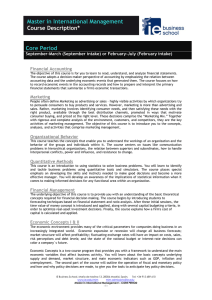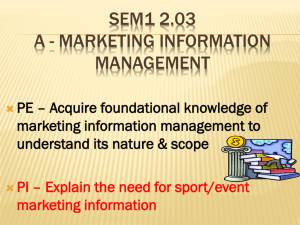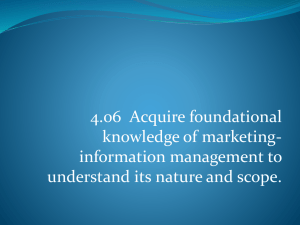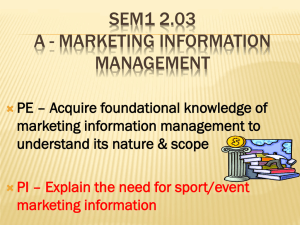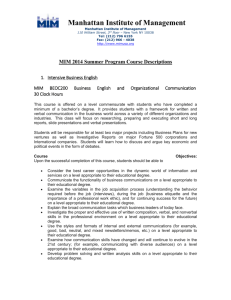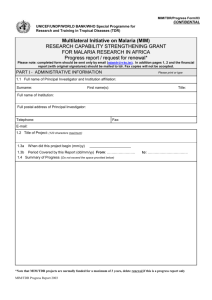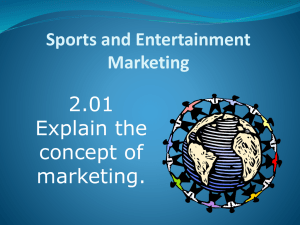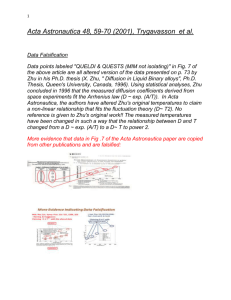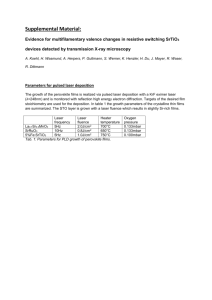PPT with more info - Buncombe County Schools
advertisement
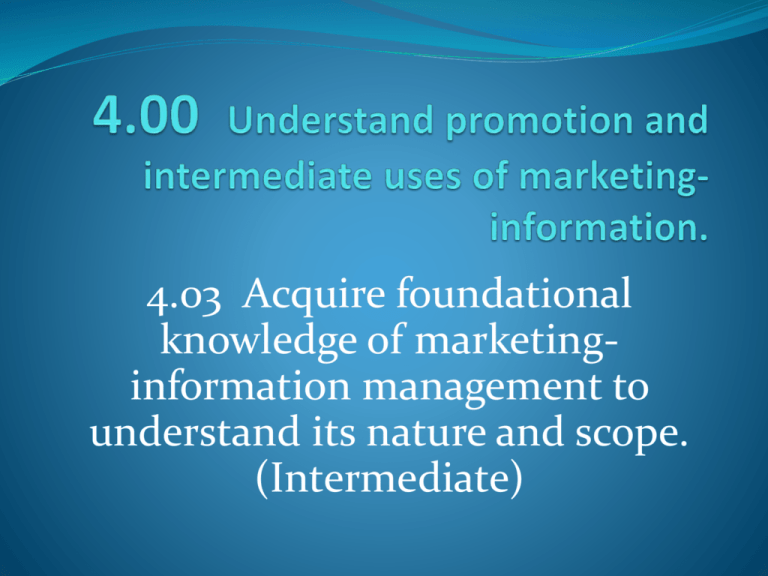
4.03 Acquire foundational knowledge of marketinginformation management to understand its nature and scope. (Intermediate) MIM Vocabulary Define the following terms: marketing information, marketing-information management system, and marketing research. Marketing Information Information gleaned from talking with the customer Marketing-Information Management System Method for collecting and analyzing/interpreting data Marketing Research Methodology for discovering the customer’s wants and needs – links consumer, customer and public to marketer Who uses marketing research? Marketing research may be formal or informal Depending on the size of the business it may be done in house (internal department) or outsourced (hire an expert) Government, opinion polls, associations and businesses use marketing research Marketing Information Management (MIM) Describe the need of marketing information. To meet a customer’s needs/wants, a company must know what s/he needs To better adapt to changing markets Classify types of marketing information as primary or secondary. Primary is information the company collects directly from its own surveys – first time collected; expensive Secondary is information the company collects from other sources (libraries, online, Federal publications, etc.) – desk research – already exists Marketing Information Management (MIM) Types of MIM Attitude Research – opinion research = feelings Market Research – info related to marketing a good/service Sales Forecasting = project future sales Economic Forecasting = predict economic future Media Research – media selection & frequency (media mix) Researching print advertisements, broadcast media, online Product Research – product design, packaging, usage New product acceptance Existing product research MIM Describe the types of information marketers should obtain. Customer preferences and opinions Competitors actions and effects on potential customers Buying habits (how often a customer repurchases) Is the correct message getting to the customers? MIM Categorize internal sources of marketing information. Customer surveys Sales people feedback Database of customers and their purchases Sales reports Company records Discuss external sources of marketing information. Federal/State/Local government Published reports from other sources (competitors, industry research, news sources) Trade reports MIM Explain why marketers should collect information. To stay ahead of the competition To better serve current customers To successfully expand into new markets To better understand the economy’s effect on its customers Answers: what should be produced, where it should be sold, how best to promote product, and at what price to sell the product MIM Describe the characteristics of useful marketing information. Can be interpreted correctly Accurate Relevant (current and useful) Describe reasons that marketers need to gather accurate information. All business decisions are based on the information collected and how that info is interpreted/analyzed MIM Explain the functions of a marketing-information management system. Collect accurate and useful data Analyze and interprets the data into usable information Shows trends and clearly explains why the market is the way it is Helps the managers make good business decisions (expand/delete a product line, enter new markets, set pricing and service policies, etc._ MIM System Contrast marketing research with a marketing- information system. Research is the collecting of data An MIM system can include research but also is responsible for assisting with making decisions Describe the use of a marketing-information system. Improve the level of satisfaction consumers feel with the company’s products Build sales and profitability MIM System Explain the benefits of a marketing-information management system Happier customers Less threat from competitors Higher profits (in the long-run) MIM System Discuss the requirements of a marketing-information management system. Collection of accurate data Effective analysis Relevant Explain the role of marketing-information management in marketing. Helps the company better understand its current and potential customers MIM System Describe limitations of marketing-information management systems Benefits of the information must be greater than the expenses of the MIM system – small businesses can’t afford the expense Significant investment of time and money The information being managed is only as good as what is collected and how it is analyzed (Garbage In, Garbage Out - GIGO) Credibility and Ethics Describe the importance of credibility and objectivity in marketing-information management. Credibility is whether the data can be trusted - Is it accurate? Objectivity addresses whether there is bias in what is collected Do we show all the information, even the stuff that makes our past decisions look bad? Do we only collect information that supports our goals or points of view? Credibility and Ethics Explain why the integrity of the marketing information must be protected. Personal information (that can be used to identify specific people) that is collected must be protected from unauthorized use. The integrity of the data is critical to its accurate analysis and interpretation Information collected unethically must be handled according to the law Ethics in MIM Explain types of ethical conflicts in marketing- information management. Keeping collected information confidential Discuss ethical issues associated with obtaining information about competitors. Corporate spying is illegal and immoral A company is allowed to use published data about competitors that is available for public use A company may not use information obtained unethically. Ethics in MIM Describe ethical issues created by the use of technology in data collection. Just like with law enforcement, technology may not be used to obtain information that the company has no right to Information collected by the company must be protected from inappropriate use or distribution Information collected from research surveys taken for one specific purpose (i.e. consumer credit) may not be used for marketing campaigns (i.e. direct mail) Use of “cookies” Technology Identify ways that the use of technology impacts the marketing-information management function. Makes it easier to collect and store certain information Information can be analyzed using specialized software Many more details can be tracked Describe how the use of the Internet for marketing- information management tracks and monitors customer website activities. Use of “cookies” Accurate count of hits to a website Technology Discuss how customer-to-business communications on the Internet can be used in marketing-information management (e.g., email reminders, popup notices, online focus groups, etc.) Computers track details well and software can provide reminders to customers Customers can choose to go to company websites and/or join online groups and submit their opinions and suggestions Technology Explain how the Internet provides services for conducting research (e.g., search engines, tools for online surveys, database access, blogs, etc.) There are many sources of information available on the Internet General and specialized libraries Search engines for finding specific sites or information Paid services that assist with locating research information Technology Discuss marketers’ use of virtual realties and simulations in marketing-information management. Marketers use games and online simulations to engage the customer and glean preference information Customers can make choices based on preset simulations and the information can be recorded to help the company better understand the mind of the consumer. Technology Describe how the use of Global Positioning Systems (GPS) can facilitate marketing-information management. Because customers aren’t always stationary and some move from one area of the state or country to another, GPS helps companies understand who is making the buying decisions Explain the use of data analysis software in marketing- information management. Specialized software allows data to be analyzed properly Can be set up to give the information in a specified format Vocabulary Define the following terms: Self-Regulation – The company or industry enforces its own rules for interacting with its customers There aren’t any specific laws or government regulations concerning that company’s or industry’s products SUGGING Selling under the guise of a survey (research) - a product marketer falsely pretends to be a market researcher conducting a survey, when in reality they are simply trying to sell the product in question FRUGGING Fundraising under the guise of a survey - a product marketer falsely purports to be a market researcher conducting a statistical survey, when in reality the "researcher" is attempting to solicit a donation SUGGing and FRUGGing http://www.dmnews.com/sugging-and-frugging- practices-as-ugly-as-they-sound/article/94425/ Vocabulary cont. Privacy The concept that an individual’s personal information (contact, SSN, preferences, etc.) are to be safely kept by the company and only shared or used as agreed to by the customer. There are legal requirements for a company to safeguard certain information There are morale obligations as well Self-regulation Explain the role of self-regulation for marketing researchers For the good of the marketing research industry, high standards are set in the way information is collected and handled This protects the industry because customers will trust the people giving the survey Any researcher failing to follow the self-regulation guidelines will be punished or expelled from the association Privacy Discuss privacy concerns associated with the collection, storage, mining, and use of data All personal data must be protected from inappropriate use Information collected for one purpose might be ineligible for use in another purpose Certain data might not be allowed to be stored (i.e. SSN) or might have to be encoded and separated from other information Legal Issues Describe the legalities associated with the collection of marketing data from children. Companies must be careful about collecting information about children under 18 years old While buying preferences and opinions are fine, personal data must be very carefully handled (think Sony Playstation fiasco) Legal Issues Discuss legal issues associated with the collection and sharing of health-care data. Health Insurance Portability and Accountability Act (HIPAA) enacted August 21, 1996 It establishes regulations for the use and disclosure of Protected Health Information (PHI). PHI is any information held by a covered entity which concerns health status, provision of health care, or payment for health care that can be linked to an individual. This is interpreted rather broadly and includes any part of an individual's medical record or payment history. They also must disclose PHI when required to do so by law, such as reporting suspected child abuse to state child welfare agencies. Legal Issues Explain legal issues associated with the protection of information held by financial institutions. Because financial institutions track personal information that includes SSN and bank account numbers, customer data must be protected from theft or unauthorized use. Improper handling or protection of the customer’s information could result in criminal prosecution or fines The financial information could be used in Identity Theft, so it must be kept safe Legal Issues Discuss why marketing researchers are excluded from governance under the CAN-SPAM Act (Controlling the Assault of Non-Solicited Pornography And Marketing Act of 2003) Researchers aren’t permitted to use their collected information for anything other than the purpose it was collected Under Federal Trade Commission - however mostly self-regulated It does not require e-mailers to get permission before they send marketing messages Legal Issues Describe legal issues associated with callbacks. Ensuring that you are talking to the same person who called in the request Being certain that you do not give out information to someone unauthorized to have it. Think medical call back (HIPAA) or school call about grades. Discuss legal issues associated with the use of automatic dialers when collecting data. Automated dialers are computers with speech recognition software. A customer could inadvertently give personal, protected, information that must then be removed or stored separately Legal Issues Ascertain the current status of privacy/data security legislation. Rules and laws are being updated to ensure the protection of identities (customers’ personal information) Discuss reasons that marketing researchers must consider state, federal, and international laws when collecting data. Legal liabilities (fines, criminal prosecution, sanctions) Test Review An example of marketing information that a business could gather by surveying its customers is the location of the company’s market. Marketers are continually gathering information because the marketing environment is constantly changing. Marketing information must be cost-effective and interpreted correctly. Ethically information must be kept confidential; only used for the original purpose it was gathered (don’t use information for non-research activity such as SUGGing and FRUGGing.) Test Review Cookies placed on a user’s hard drive when the user visits the business’s web site help a business to customize its marketing efforts. By creating a database of information about customers’ purchases, brand preferences, dollar amounts spent, preferences and buying habits a business can track the number of times the user buys a product and builds strong, loyal customer relationships.
